TS-ENC540
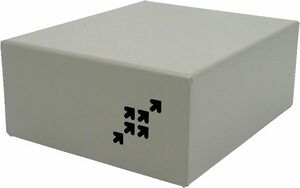 | |
| Product Page | |
| Documentation | |
|---|---|
| Schematic |
Overview
Introduction
The TS-ENC540 metal enclosure is made to house the TS-5400 Single Board Computer and two PC/104 peripheral boards. The switching power regulator efficiently converts 12-38 VDC to regulated +5 VDC required by the SBC.
Features and Benefits
- 12-38 VDC input provides +5VDC to the SBC
- COM ports adapted to standard 9 pin Sub-D
- Back panel connector for optional COM3
- Status LED's for Ethernet ports are visible
- Power Good LED visible at back panel
- Reset button recessed into back panel
- Surge suppression on DC power input
- Sturdy metallic design reduces noise
- Dimensions 2-3/8" x 5" x 6"
- Related Products
The TS-ENC540 enclosure is designed for the TS-5400 Single Board Computer and two of the PC/104 peripheral boards.
Installing the Enclosure
Electrostatic Discharge (ESD) precautions
Before performing any set up or placement procedures, take the precautions outlined in this section.
| WARNING: | Be sure to take appropriate Electrostatic Discharge (ESD) precautions. Disconnect the power cable at the rear panel of the enclosure before moving, cabling, or performing any set up procedures. |
Setup and Installation Instructions
Follow these guidelines for safety and maximum product performance:
- Observe local health and safety requirements and guidelines for manual material handling.
- Set the enclosure on a level surface with adequate ventilation.
- Ensure the rubber feet are used for protection and stability on level surfaces.
- Wall-mount the unit if placement on a level surface is not available, or desired.
Setup Tools
Depending on the placement and cabling of the enclosure, you may need the following tools:
- Small flat-blade screwdriver
- Small Phillips screwdriver
Setup Procedure
After locating, setting up, grounding, and cabling the enclosure:
1. Apply power to the unit.
The amber-colored LED on the rear panel should be lit.
2. Monitor COM2 using a terminal emulator to verify that the enclosure is operating properly.
Disconnecting AC Power
1. Unplug the power cord from the power source. 2. Disconnect the power cord from the rear panel of the enclosure.
Components
Standard Headers and Connectors
Front Panel
See Appendix A for a view of the enclosure’s front panel.
Rear Panel

The rear panel of the metal enclosure has four connectors and two additional elements, as indicated in the above view. Identifiers, and a description for each, are listed in the tables below.
| Identifier | Connector Description |
|---|---|
| 1 | Ethernet 0 |
| 2 | Ethernet 1 |
| 3 | COM1 |
| 4 | COM2 |
| 5 | COM3 |
| 6 | 12-38VDC |
Additional Elements
| Identifier | Description |
|---|---|
| 7 | Power Indicator LED |
| 8 | Chassis Grounding Lug |
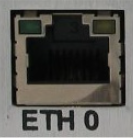
|
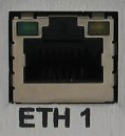
|
| Enclosure TS-540 Ethernet Ports 0 and 1 | |
- Ethernet: The Ethernet connectors are standard RJ-45 sockets. They can be used to connect a standard 10/100 Ethernet cable into the enclosed EPC.
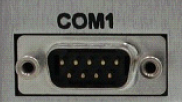
- COM1: COM1 is brought in from the enclosed SBC. This 9-pin SubD connector is industry standard for a PC. The TxD, RxD, RTS, CTS, and ground pins are supported for RS-232 communications.
See the table below for RS-485 operation.
COM1 9-Pin SubD Outs Table
| Duplex RS-485 | RS-232 | Full Duplex RS-485 | |||
|---|---|---|---|---|---|
| 9-Pin SubD | Signal | 9-Pin SubD | Signal | 9-Pin SubD | Signal |
| 1 | RX/TX+ | 1 | 1 | TX+ | |
| 2 | 2 | Receive data | 2 | ||
| 3 | 3 | Transmit data | 3 | ||
| 4 | 4 | 4 | RX+ | ||
| 5 | Ground | 5 | Ground | 5 | Ground |
| 6 | RX/TX- | 6 | 6 | TX- | |
| 7 | 7 | Request to Send | 7 | ||
| 8 | 8 | Clear to Send | 8 | ||
| 9 | 9 | 9 | RX- | ||
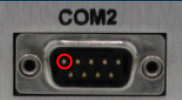
- COM 2: COM2 is brought in from the base SBC. This 9-pin SubD connector is industry standard for a PC. The TxD, RxD, RTS, CTS, and ground pins are supported for RS-232 communications.
COM2 9-Pin SubD Outs Table
| RS-232 | |
|---|---|
| 9-Pin SubD | Signal |
| 1 | |
| 2 | Receive data |
| 3 | Transmit data |
| 4 | |
| 5 | Ground |
| 6 | |
| 7 | Request to Send |
| 8 | Clear to Send |
| 9 | |

- COM 3: COM3 is brought in from the base SBC. This 9-pin SubD connector is industry standard for a PC. The TxD, RxD, RTS, CTS, and ground pins are supported for RS-232 communications.
COM3 9-Pin SubD Outs Table
| RS-232 | |
|---|---|
| 9-Pin SubD | Signal |
| 1 | |
| 2 | Receive data |
| 3 | Transmit data |
| 4 | |
| 5 | Ground |
| 6 | |
| 7 | Request to Send |
| 8 | Clear to Send |
| 9 | |

- 12-38VDC: The three-pin connector accepts 12-38 VDC of external power to supply power to the board.

- Power Indicator Light: The amber-colored LED indicator on the rear panel, shown highlighted above in red, is the power LED. It is lit whenever power is applied to the unit.

- Chassis Grounding Lug: The lug labeled with the chassis ground symbol is used to
ground the chassis (optional).
| Note: | Connect this to earth ground during installation. |
Product Specifications
Dimensions
The TS Enclosure 540 measures 2-3/8" x 5" x 6"
Cabling
- A mating power connector is supplied with the enclosure
- A null modem cable is available as CB7-05
Environmental
To ensure optimum product operation you must maintain the operational environmental specifications listed in the table below.
| Environmental Specifications | Standard Temp Products | Extended Temp Products |
|---|---|---|
| Ambient Temperature | 0 - 60°C The internal temperature must not exceed +70°C |
Allow for a much greater range. Note: Refer to your product manual, or contact Customer Service at Technologic Systems if the environmental temperature of the location is in doubt. |
| Relative Humidity | Not to exceed 90% noncondensing |
Not to exceed 90% noncondensing |
Options and Other Features
- RS-485 is optional on COM1
- A wall-mounted power supply is available for this product
Limited Warranty
See our Terms and Conditions for more details.
Regulatory Notices
FCC Advisory Statement
This equipment generates, uses, and can radiate radio frequency energy and if not installed and used properly (that is, in strict accordance with the manufacturer's instructions), may cause interference to radio and television reception. It has been type tested and found to comply with the limits for a Class A digital device in accordance with the specifications in Part 15 of FCC Rules, which are designed to provide reasonable protection against such interference when operated in a commercial environment. Operation of this equipment in a residential area is likely to cause interference, in which case the owner will be required to correct the interference at his own expense.
If this equipment does cause interference, which can be determined by turning the unit on and off, the user is encouraged to try the following measures to correct the interference:
Reorient the receiving antenna. Relocate the unit with respect to the receiver. Plug the unit into a different outlet so that the unit and receiver are on different branch circuits. Ensure that mounting screws and connector attachment screws are tightly secured. Ensure that good quality, shielded, and grounded cables are used for all data communications. If necessary, the user should consult the dealer or an experienced radio/television technician for additional suggestions. The following booklets prepared by the Federal Communications Commission (FCC) may also prove helpful:
How to Identify and Resolve Radio-TV Interference Problems (Stock No. 004-000-000345-4) Interface Handbook (Stock No. 004-000-004505-7) These booklets may be purchased from the Superintendent of Documents, U.S. Government Printing Office, Washington, DC 20402.
Appendix A: Enclosure Views
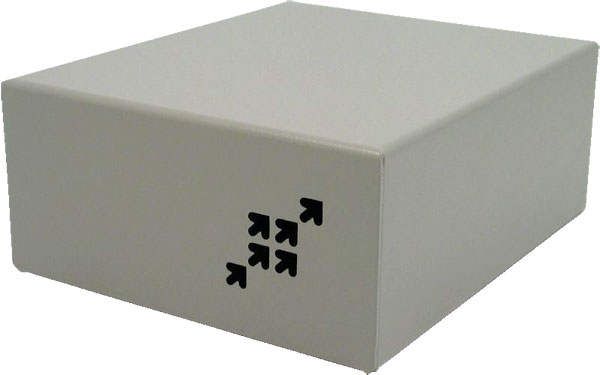
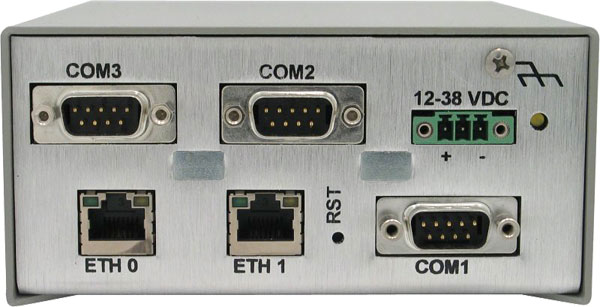
TS-ENC540 Board
